
Bashkirsky Nature Reserve (Zapovednik) is located in the central part of the Bashkir (Southern) Urals. It features forested mountain slopes from the western slopes of the southern Ural Mountains to the Kaga River, and a displays the transition from mountain forest to steppe-forest. The reserved is situated in the Burzyansky District of Bashkortostan.

Kerzhinski Nature Reserve is a Russian 'zapovednik' located in the middle basin of the Kerzhenets River, 600 kilometres (370 mi) east of Moscow. The terrain features extensive upland and lowland swamps, and is known in particular as a site for the study of beavers, and their effects on recovery of the landscape after fires and logging. The reserve is situated 55 km northeast of the City of Nizhny Novgorod in the Bor and Semonov districts of Nizhny Novgorod Oblast. The site has been a center for scientific study of nature of the region since 1933. It is part of a UNESCO Biosphere Reserves, Ramsar wetland. The reserve was established in its current form in 1993, and covers an area of 46,940 ha (181.2 sq mi).

Voronezh Nature Reserve is a Russian 'zapovednik' located 40 km north of the city Voronezh and 500 km south of Moscow. One of the oldest nature reserves in Russia, Voronezh was the world's first experimental beaver nursery for breeding and studying the beaver. The reserve is situated in the Usmansky District of Voronezh Oblast, and in Lipetsk Oblast. It is part of a UNESCO-MAB Biosphere Reserve. Its official name as of 2013 is "Voronezh Peskov Nature Reserve" in honor of journalist and writer Vasily Peskov. The reserve was created in 1927, and covers an area of 31,053 ha (119.90 sq mi).

Zhiguli Nature Reserve is a Russian 'zapovednik' located on the Samara Bend in the Samara region, where the Volga River swings around the Zhiguli Mountains. The reserved is situated in the Stavropolsky District of Samara Oblast. The reserve is important because of its scientific value in the biodiversity of its closely placed variety of habitats. In 2007, the Zhiguli Reserve was added to the UNESCO Middle Volga Biosphere Reserve, along with the surrounding Samarskaya Luka National Park.
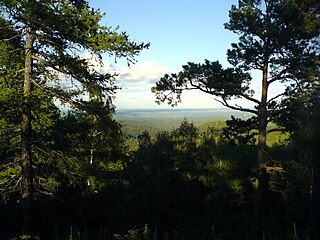
Ilmen Nature Reserve is a Russian 'zapovednik' that was created by decree of Vladimir Lenin, in 1920 as a mineralogical nature reserve. It is the site of deposits of many rare-earth minerals - 16 minerals were first discovered here, including Ilmenite, Monazite, Cancrinite, and Samarskite-(Y). There have been over 400 mines in the area over the years. The Reserve's geological museum is one of the largest in Russia. The forest cover is pine and larch forest on low hills of the Ilmensky Mountains and foothill ridges on east side of the south Ural Mountains. The reserve is situated just north and east of the city of Miass, in the Chebarkulsky District of Chelyabinsk Oblast. It is also 20 kkm east of Taganay National Park and 75 km west of Chelyabinsk.

Belogorye Nature Reserve is a Russian 'zapovednik', one of the last intact riverine old-growth oak forests, which was once representative of the East European forest-steppe. The reserve is one of the oldest and smallest nature reserves in Russia, first formed in 1924 but reorganized several times since. It is on the southwestern slope of the Central Hills on the western edge of Russia. The reserve is situated in the Belgorodsky District of Belgorod Oblast. The reserve was created in 1935, and covers an area of 2,131 ha (8.23 sq mi).

Shulgan-Tash Nature Reserve is a Russian 'zapovednik' in the western foothills of the Southern Ural Mountains. The terrain is one of heavy forest and karst topography; the site contains some of the oldest caves of human habitation. The reserve has 13 full-time "bortniks" - practitioners of the ancient apiculture (bee-keeping) of tree-hollow cultivation of wild honeybees. The reserve is situated in the Burzyansky District of Bashkortostan. It is about 40 km southeast of the District town of Starosubkhangulovo. In 2012, the reserve was added to the UNESCO Biosphere Reserve "Bashkir Ural", in particular for protection of the Burzyuan bee, which has been cultivated since ancient times by the local Bashkir people.

The Khopyor Nature Reserve is a Russian zapovednik that protects a 50-km-long stretch of the Khopyor River in the Voronezh Oblast. About 80% of the area is covered by forests, floodplain, and upland oak woods, with small areas of steppe and meadowlands. There are about 400 lakes and oxbows. The reserve is situated in the Novokhopyorsky District of Voronezh Oblast.
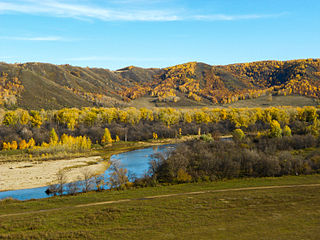
Shaytan-Tau Nature Reserve is a Russian 'zapovednik' located along the Shaytantau ridge of the Southern Urals. The ridge contains limestone reefs which are of Cambrian age, almost 500 million years old. The main purpose of the reserve is to conserve representative Dubravnaya steppe and low-lying bog habitats of relict and endemic species of plants and animals. The area is the youngest federal reserve in the Urals, being set aside for protection on October 9, 2014. It is separated into four sectors, situated in both the Kuvandyksky District of Orenburg Oblast, and in Bashkortostan. It is about 220 km from the regional city of Orenburg.
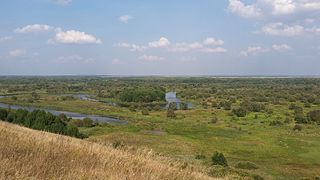
Voronina (Voroninsky) Nature Reserve is a strict ecological reserve located in the valley of the Vorona River, in the forest-steppe zone of southwest Russia. The Voroninsky Reserve protects riverine wetlands in the southeast of the Oka–Don Plain. The reserve is situated in Kirsanovsky and Inzhavinsky districts of Tambov Oblast, about 100 km southeast of the city of Tambov. It was created in 1994, and covers an area of 10,819 ha (41.77 sq mi).

Kaluzhskiye Zaseki Nature Reserve is a Russian zapovednik. Zaseki in Russian means abatises, field fortifications made of felled trees. In medieval times, the Kaluga region was part of the defensive line between the Russian forests to the north and potential invaders from the south. The reserve has been protected in some form for a thousand years, and remains old-growth forest. The reserve is situated in the Ulyanovsky District, Kaluga Oblast. It was formally established in 1992 and has an area of 18,533 hectares (71.56 sq mi).

Sayano-Shushenski Nature Reserve is a Russian 'zapovednik' reserve in a remote area of the West Sayan Mountains of south Siberia. It is on the southern bank of the Yenisei River along the Sayano-Shushenskoye reservoir. The reserve thus protects a large section of the wooded, mountainous territory above the reservoir created by the Sayano-Shushenskaya Dam, the largest power plant in Russia. Both the reserve and the dam were established 1976, and a major purpose of the reserve besides conservation is the study of the ecological effects of a large reservoir on the local ecology. The reserve covers an area of 390,368 ha (1,507.22 sq mi). It is situated in the Shushensky District of Krasnoyarsk Krai.

Volga-Kama Nature Reserve is a Russian 'zapovednik' at the confluence of the Volga River, the Kama River, and the Myosha River. There are two sections to the reserve, one on the left bank terraces of the Volga, at the actual meeting point of the rivers, the other section about 100 km up the Volga on the western outskirts of the city of Kazan. The reserve is situated in the Zelenodolsky Districts and Laishevsky District of Tatarstan. It was formally established in 1960 to protect remaining forest and forest-steppe habitat of the middle Volga region, and has an area of 8,024 ha (30.98 sq mi). A particular focus of scientific study is the effects of the Kuybyshev Reservoir on the local environment. The reservoir was completed in the mid-1950s, and is the largest reservoir in Europe. The Volga-Kama Reserve is part of a UNESCO Biosphere Reserve.

Kuznetsk Alatau Nature Reserve is a Russian 'zapovednik' on the Kuznetsk Alatau, a mountain ridge in the Altai-Sayan mountain region in southwestern Siberia. The Kuznetsk Alatau consists of several ranges of medium height, between which there are river valleys. The reserve is in the watershed of the Tom River and the Chuly River. It is spread over three districts of Kemerovo Oblast: Tisulsky District, Mezhdurechensky District, and Novokuznetsky District. The reserve was established in 1989 and covers an area of 412,900 ha (1,594 sq mi).

Privolzhskaya Lesostep Nature Reserve is a Russian zapovednik situated in the watershed midway between the Volga River and the Don River. The reserve is divided into 5 sectors, all in the western part of the Volga Uplands. Three of the sectors are steppe terrain, and two are forests. Rivers with upper reaches in the reserve flow into both the Don and the Volga. Administratively, the reserve is situated in the Kuznetsky District of Penza Oblast. The reserve was formally established in 1989 with the stated purpose of protecting representative habitat of the northern steppes, and the transition zone from steppe to forest. Some sections of the reserve, however, have been protected since 1919. In all, the reserve sectors cover an area of 8,373 ha (32.33 sq mi), and has additional buffer zones out to 1 km from the reserve borders.
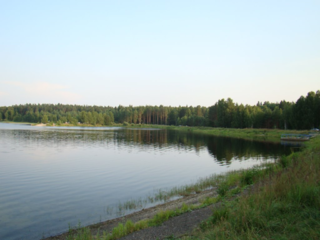
Mordovski Nature Reserve is a Russian 'zapovednik' in the north of the Republic of Mordovia, on the forested right bank of the Moksha River. It is in the transition zone of coniferous-deciduous forests and steppe. The reserve covers one-sixth of the Temnikovsky District of Mordovia. It was formally established in 1935, and covers a total area of 32,148 ha (124.12 sq mi). Its official name honors Pyotr Smidovich, a Soviet revolutionary and government official who was instrumental in establishing the Mordovsky Reserve.
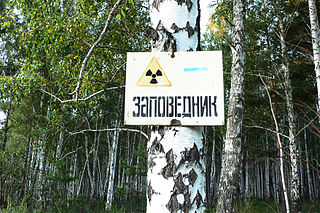
East Ural Nature Reserve is a Russian 'zapovednik' that is near the site of the 1957 Kyshtym disaster, the world's second highest radioactivity release after Chernobyl. As a state "radiation reserve", the site functions for the protection of a contaminated area, and for long-term scientific study of the effects of radiation on the forest-steppe ecology on the east slope of the southern Ural Mountains. The reserve is situated in the Ozyorsk, Chelyabinsk Oblast. It was formally established in 1968, and covers 16,600 ha. The reserve, as of 2007, is under the control of Rosatom, a state-run corporation, which conducts regular radiation and radio ecological monitoring.

Tigirekskiy Nature Reserve is a Russian 'zapovednik' in the northwest mid-level mountains of the Altai-Sayan region. The reserve was established for the protection and study of the relic pre-glacial dark taiga of the higher elevations, and the mountain-steppe of the river valleys and lower regions. The site features extensive karst landscape and caves. The reserve is situated in the Zmeinogorsky, Tretyakovsky and Krasnoshchyokovsky districts of Altai Krai. It was formally established in 1999, and covers a total area of 40,693 ha (157.12 sq mi).
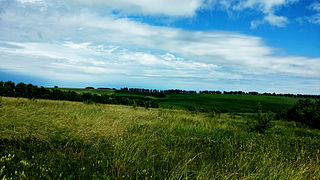
The East European forest steppe ecoregion is a patchwork of broadleaf forest stands and grasslands (steppe) that stretches 2,100 km across eastern Europe from the Ural Mountains in Ural, through Povolzhye, Central Russia to the middle of Ukraine. There are isolated areas of similar character off the western end in eastern Romania, Moldova, and Bulgaria.
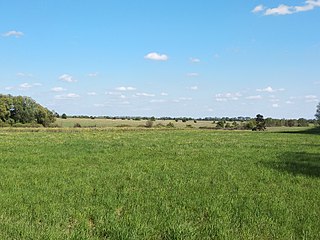
Michael's Virgin Land Nature Reserve is a protected nature reserve of Ukraine that covers meadow-steppe and forest-steppe in the northeast of Ukraine near the border with Russia. It exhibits plants found in both northern and southern steppes. First created as a reserve in 1928, it was expanded over the years and formally upgraded to a national reserve in 2009. The reserve is in the administrative districts of Lebedyn and Nedryhailiv of Sumy Oblast.





















